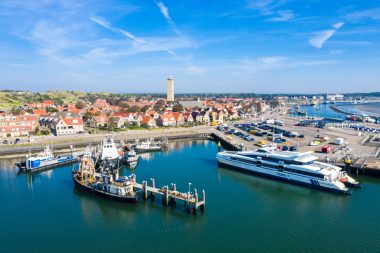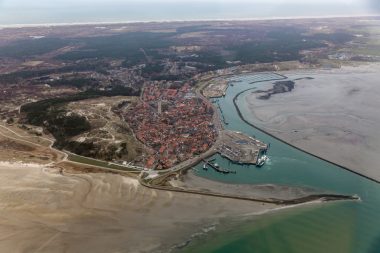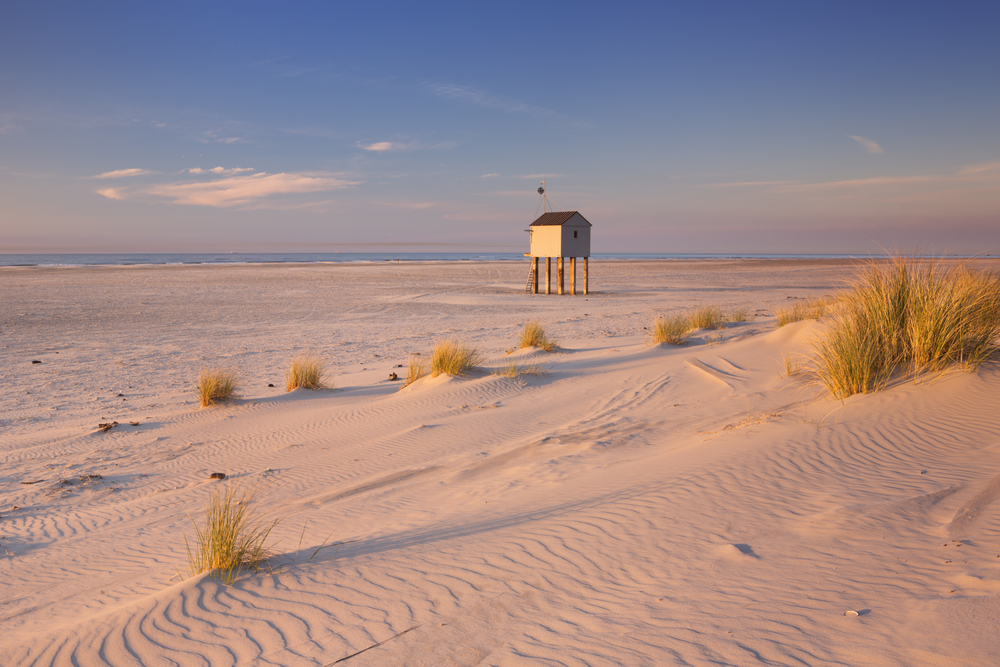Hardly any other North Sea island is as varied and suitable for every type of holidaymaker as the West Frisian island of Terschelling in the Netherlands. Whether kite surfers, beach hikers, ornithologists, cyclists or partygoers – everyone feels at home on Terschelling. A diverse landscape is spread over a length of almost 29 kilometres and a width of 4.5 kilometres: extensive beaches, high dune belts, polder plains, forests and swamps in which a remarkable variety of birds and butterflies cavort.
The crossing from Harlingen to Terschelling
The journey begins in the ferry port of Harlingen, the car may be with you, but does not have to. There is sufficient long-term parking space available in Harlingen. Those in a hurry use the fast ferry (but without a car), which reaches Terschelling in 45 minutes. A holiday from the very beginning is the journey with the large car ferry, which takes 120 minutes for the crossing. It is incomparable when the ponderous car ferry carefully feels its way through the fairway of the Wadden Sea in serpentine lines, while you watch the seals lolling in the sun on glittering sandbanks from the deck with binoculars.
The first impression – arrival in West-Terschelling

Terschelling’s villages introduce themselves
In the middle of the island, the village of Midsland has made a name for itself as a party location. There are plenty of shops to provide the necessary outfit. Cafés, pubs, affordable restaurants and nightclubs cater to the younger crowd that comes to the island to party, especially during the summer holidays. The further east you go, the quieter the villages become. Formerum is a quiet, family-friendly resort. This is where Terschelling’s only windmill is located. In the wreck museum, objects recovered from shipwrecks from the period from 1650 to the present day can be viewed. In Hoorn, a small shopping street satisfies daily and tourist needs. Worth seeing is the “Sint Janskerk”, a church from the 13th century. In a small museum below the tower, coins and other objects are exhibited that were found in the ground during restoration work. The Agricultural Museum with adjoining children’s farm is a popular destination for families with children. Oosterend is the easternmost village on the island and the starting point for trips to the nature reserve “De Boschplaat”. The Boschplaat is 10 kilometres long and 5 kilometres wide. About 65 species of birds breed here, including the lesser black-backed gull, the herring gull and the spoonbill. As a result, the nature reserve is not open to the public during the breeding season between 15 March and 15 August. However, a narrow sandy path on the dune summit leads along the breeding area, which is open all year round.
The North Sea beach – Terschelling’s capital
Many holidaymakers come to Terschelling because of the beach. On 30 kilometres of beach, everyone will find their own place. At West-Terschelling there is still a lively hustle and bustle, between Formerum and Oosterend you have the beach almost all to yourself. There are several beach pavilions along the beach. Here you can eat or drink something and rent umbrellas and sunbeds. An insider tip is the beach pavilion “Heartbreak Hotel”, which is the easternmost beach pavilion on the island in Oosterend – in the immediate vicinity of the “Boschplaat”. Furnished in the style of the 50s and 60s, the unforgettable hits of Elvis Presley, Chuck Berry or Johnny Cash can be heard from the loudspeakers. Some of the beach pavilions are even open in winter – a fantastic experience to stop for a warm drink with a sea view after a stormy walk on the beach. Due to the vastness of the beach, everyone can practice their beach sport: swimming, surfing, kiting, sand yachting, beach rides, flying kites.
It never gets boring on Terschelling

Red, round and healthy – the cranberry
A trademark of the island is the cranberries, a cranberry originally native to North America, which washed up on the island after shipwrecks and multiplied wildly. The health-promoting effect of cranberries was quickly discovered and marketed. Cranberries are available for sale as juice, jelly or jam, as well as wine or liqueur.
Travel information for a holiday on Terschelling
1. General information
- Location: In the North Sea, part of the West Frisian Islands, province of Friesland.
- Area: Approx. 88 km².
- Population: About 5,000.
- Language: Dutch and West Frisian. Many locals speak English and often German.
- Currency: Euro (EUR).
- Time zone: Central European Time (CET), in summer CEST.
2. Arrival
- Ferry: The island can be reached by ferry from Harlingen. There are two types of ferries:
- Regular ferry: Takes about 2 hours.
- Fast ferry (Watertaxi): Takes about 45 minutes.
- Harlingen: Easily accessible by car, train or bus. Parking facilities for vehicles are available in Harlingen, as cars are usually not necessary on Terschelling.
- Airports: The nearest airport is Amsterdam Schiphol. From there you can take the train to Harlingen.
3. Best time to travel
- Summer (May to September): Ideal for beach and outdoor activities.
- Winter: Quieter but perfect for hiking and peace seeking travelers.
- Events:
- Oerol Festival (June): A famous theatre and arts festival that transforms the entire island into one big stage.
- Horizontoer (August): Music and sailing festival.
4. Transportation on the island
- Bicycle: Bicycles are the main means of transport on Terschelling. Numerous bicycle rentals are available.
- Public transport: Buses connect the main villages.
- Car: With permission you can take cars to the island, but this is often not necessary.
5. Activities and sights
- Beaches:
- Miles of wide sandy beaches, ideal for sunbathing, hiking or water sports.
- De Boschplaat National Park: A UNESCO biosphere reserve with a unique flora and fauna. Perfect for bird watching and hiking.
- Villages:
- West-Terschelling: Main town with the striking Brandaris lighthouse (oldest lighthouse in the Netherlands).
- Oosterend: Quiet place near De Boschplaat.
- Midsland: Charming village with shops and restaurants.
- Wadden Sea hiking: Guided hikes through the Wadden Sea, a unique experience.
- Water sports: Kitesurfing, sailing and stand-up paddle boarding are popular activities.
6. Accommodation
- Campsites: From simple pitches to comfortable glamping offers.
- Hotels and guesthouses: There are many options, especially in West-Terschelling and Midsland.
- Holiday homes: Ideal for families or longer stays.
- Special accommodations: Sleeping in dune lodges or renovated farms.
7. Culinary delights
- Regional specialities:
- Sheep’s and cow’s cheese: Locally produced.
- Sea fish: Freshly caught herring, mussels and crabs.
- Cranberries: The island is known for its cranberry products, including jams and liqueurs.
- Local breweries: Try beers from the Terschellinger Brewery.
8. Practical tips
- Weather: The climate is maritime. Pack windproof and rainproof clothing, even in summer.
- Internet and electricity: Wi-Fi is available in many accommodations. Power supply meets the European standard (230V).
- Dogs: Dogs are welcome on the island, including on many beaches. There are designated free-run zones.
9. Sustainability
Terschelling attaches great importance to sustainability. Many accommodations and providers work in an environmentally friendly way. Recycling and avoiding plastic are common practices.


